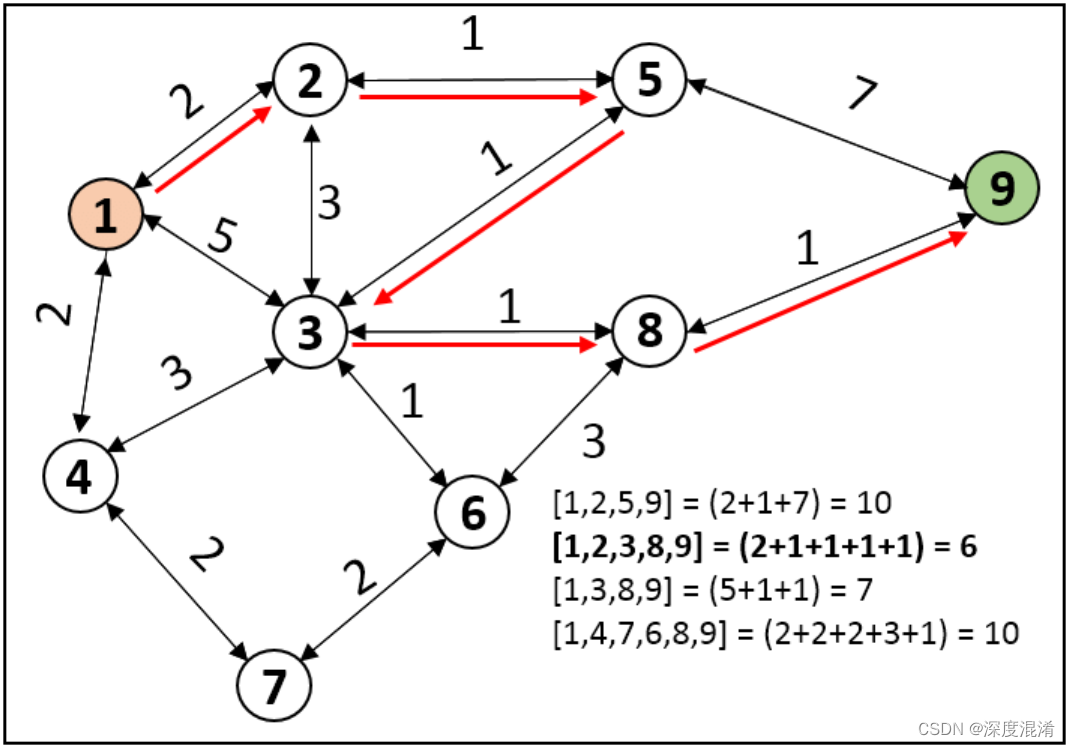C#,图论与图算法,图最短路径的迪杰斯特拉(Dijkstra)算法与源代码

给定一个图和图中的源顶点,查找从源到给定图中所有顶点的最短路径。
Dijkstra的算法与Prim的最小生成树算法非常相似。像Prim的MST一样,我们生成一个以给定源为根的SPT(最短路径树)。我们维护两个集合,一个集合包含最短路径树中包含的顶点,另一个集合包含最短路径树中尚未包含的顶点。在算法的每个步骤中,我们都会找到另一个集合(尚未包含的集合)中的顶点,该顶点与源之间的距离最小。
下面是Dijkstra算法中使用的详细步骤,用于查找从单个源顶点到给定图中所有其他顶点的最短路径。
算法
1) 创建一个集sptSet(最短路径树集),用于跟踪最短路径树中包含的顶点,即计算并最终确定其与源的最小距离。最初,此集合为空。
2) 为输入图形中的所有顶点指定距离值。将所有距离值初始化为无穷大。将源顶点的距离值指定为0,以便首先拾取该顶点。
3) 而sptSet不包括所有顶点
….a) 拾取sptSet中不存在且具有最小距离值的顶点u。
….b) 包括u到sptSet。
….c) 更新u的所有相邻顶点的距离值。若要更新距离值,请遍历所有相邻顶点。对于每个相邻顶点v,如果u(从源)的距离值和边u-v的权重之和小于v的距离值,则更新v的距离值。

Dijkstra算法允许我们找到图中任意两个顶点之间的最短路径。
它不同于最小生成树,因为两个顶点之间的最短距离可能不包括图的所有顶点。
Djikstra在相反的方向上使用了这个属性,即我们高估了每个顶点到起始顶点的距离。然后我们访问每个节点及其邻居,以找到这些邻居的最短子路径。
该算法使用贪婪的方法,即我们找到下一个最佳解决方案,希望最终结果是整个问题的最佳解决方案。
参考:
Djikstra算法源程序:
using System;
using System.Text;
namespace Legalsoft.Truffer.Algorithm
{
public partial class Graph
{
private static int Minium_Distance(int Vertex_Number, int[] dist, bool[] sptSet)
{
int min = int.MaxValue;
int min_index = -1;
for (int v = 0; v < Vertex_Number; v++)
{
if (sptSet[v] == false && dist[v] <= min)
{
min = dist[v];
min_index = v;
}
}
return min_index;
}
public static int[] Dijkstra(int Vertex_Number, int[,] graph, int src)
{
int[] dist = new int[Vertex_Number];
bool[] sptSet = new bool[Vertex_Number];
for (int i = 0; i < Vertex_Number; i++)
{
dist[i] = int.MaxValue;
sptSet[i] = false;
}
dist[src] = 0;
for (int count = 0; count < Vertex_Number - 1; count++)
{
int u = Minium_Distance(Vertex_Number, dist, sptSet);
sptSet[u] = true;
for (int v = 0; v < Vertex_Number; v++)
{
if (!sptSet[v] && graph[u, v] != 0 && dist[u] != int.MaxValue && dist[u] + graph[u, v] < dist[v])
{
dist[v] = dist[u] + graph[u, v];
}
}
}
return dist;
}
}
public static partial class GraphDrives
{
public static string Dijkstra()
{
int[,] graph = new int[,] {
{ 0, 4, 0, 0, 0, 0, 0, 8, 0 },
{ 4, 0, 8, 0, 0, 0, 0, 11, 0 },
{ 0, 8, 0, 7, 0, 4, 0, 0, 2 },
{ 0, 0, 7, 0, 9, 14, 0, 0, 0 },
{ 0, 0, 0, 9, 0, 10, 0, 0, 0 },
{ 0, 0, 4, 14, 10, 0, 2, 0, 0 },
{ 0, 0, 0, 0, 0, 2, 0, 1, 6 },
{ 8, 11, 0, 0, 0, 0, 1, 0, 7 },
{ 0, 0, 2, 0, 0, 0, 6, 7, 0 }
};
StringBuilder sb = new StringBuilder();
sb.AppendLine("Vertex Distance from Source<br>");
sb.AppendLine("<style>");
sb.AppendLine("td { padding:5px;text-align:right; }");
sb.AppendLine("</style>");
sb.AppendLine("<table width='100%' border=1 bordercolor='#999999' style='border-collapse:collapse;'>");
sb.AppendLine("<tr>");
sb.AppendLine("<td></td>");
for (int j = 0; j < 9; j++)
{
sb.AppendLine("<td style='background-color:#EEEEFF;'>" + j + "</td>");
}
sb.AppendLine("</tr>");
for (int i = 0; i < 9; i++)
{
int[] dist = Graph.Dijkstra(9, graph, i);
sb.AppendLine("<tr>");
sb.AppendLine("<td style='background-color:#EEEEFF;'>" + i + "</td>");
for (int j = 0; j < 9; j++)
{
sb.AppendLine("<td>" + dist[j] + "</td>");
}
sb.AppendLine("</tr>");
}
sb.AppendLine("</table>");
return sb.ToString();
}
}
}
POWER BY 315SOFT.COM

相关文章
- C#数据Encrypt加密Encrypt解密的算法使用--非对称算法RSACryptoServiceProvider
- C#反射机制介绍
- C#数据结构与算法揭秘八
- Win10系列:C#应用控件基础10
- 揽货最短路径解决方案算法 - C# 蚁群优化算法实现
- .Net(c#)加密解密工具类:
- 重新整理数据结构与算法(c#)——算法套路k克鲁斯算法[三十]
- 重新整理数据结构与算法(c#)—— 算法套路分治算法[二十五]
- 重新整理数据结构与算法(c#)—— 算法套路二分法[二十四]
- 重新整理数据结构与算法(c#)—— 二叉树排序树[二十二]
- 重新整理数据结构与算法(c#)—— 顺序存储二叉树[十九]
- 重新整理数据结构与算法(c#)—— 树的节点删除[十八]
- 重新整理数据结构与算法(c#)—— 算法套路动态规划算法[二十六]
- 重新整理数据结构与算法(c#)—— 堆排序[二十一]
- c# TryParse
- c# 优化代码的一些规则——用委托表示回调[五]
- C# 多线程参数传递
- C# 使用NPlot绘图
- 【C#代码实战】群蚁算法理论与实践全攻略——旅行商等路径优化问题的新方法
- Atitit.跨语言异常转换机制 java c# php到js的异常转换
- Atitit.jsou html转换纯文本 java c# php
- C# WinForm程序的App.Config数据库连接配置文件
- C# 常量
- c# winfrom 可折叠的树形控件
- c#QQ连连看辅助
- C#+无unsafe的非托管大数组(large unmanaged array in c# without 'unsafe' keyword)
- C#获取特定进程CPU和内存使用率
- C#编程之Linq-语言集成查询
- C#之十大排序算法
- 本文详细阐述如何用C#创建COM组件,并能用VC6.0等调用。
- C#中的运算符和异常处理

